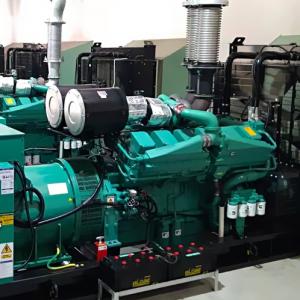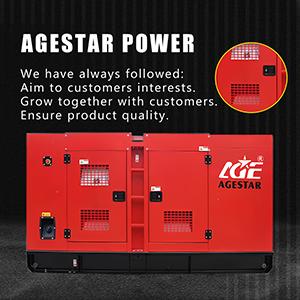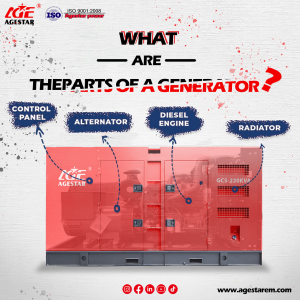Diesel generator (Introduction-II)
Principle
In short, the diesel generator drives the generator.
In the cylinder, the clean air filtered by the air filter is fully mixed with the high-pressure atomized diesel fuel injected from the injector. Under the upward squeeze of the piston, the volume shrinks and the temperature rises rapidly, reaching the ignition point of the diesel fuel. The diesel is ignited, the mixed gas burns violently, expands rapidly in volume, and pushes the piston downward, which is called 'work'. Each cylinder performs work in a certain order, and the thrust acting on the piston becomes a force that drives the crankshaft to rotate through the connecting rod, thereby driving the crankshaft to rotate. By installing the brushless synchronous alternator coaxially with the crankshaft of the diesel generator, the rotation of the diesel generator can be used to drive the rotor of the generator. Using the principle of 'electromagnetic induction', the generator will output an induced electromotive force through a closed load circuit. can produce current.
Only the most basic working principle of the generator set is described here. In order to obtain usable and stable power output, a series of diesel generators and generator control, protection devices and circuits are also required.
Island operating mode
Operating one or more diesel generators without being connected to the grid is known as islanding mode of operation. Working generators in parallel provide better efficiency at part load. An island power plant used as the main power source for an isolated community will typically have at least three diesel generators, any two of which are rated to carry the required load.
Generators can be electrically connected together through a synchronization process. Synchronization involves matching voltage, frequency and phase before connecting the generator to the system. Failure to synchronize before connection may result in high short-circuit current or wear and tear on the generator or its switching equipment. The synchronization process can be done automatically by the auto-sync module, or manually by a guided operator. The automatic synchronizer will read the voltage, frequency and phase parameters from the generator and bus voltage while regulating the speed through the engine governor or ECM (Engine Control Module).
Load can be shared between generators operating in parallel through load sharing. Load sharing can be achieved by using droop speed control controlled by the generator frequency, while it continuously adjusts the engine fuel control to transfer load to or from the remaining power source. A diesel generator will take on more load when the fuel supply to its combustion system increases, and release the load if the fuel supply decreases.
Unit Type
The packaged combination of a diesel engine, generator and various auxiliary devices such as base, top cover, sound attenuation, control system, circuit breaker, jacketed water heater and starting system is called a "generator set".Standard unit
Standard units are widely used in general places installed in computer rooms. The unit is mainly composed of diesel engine, generator, control system, machine base, shock absorber, cooling system, oil supply system, and output protection switch.
Protective unit
Protective units are used in outdoor places where there are no special requirements for noise. It is mainly composed of standard unit, protective cover, smoke exhaust system, etc. Since the protective cover is not equipped with a noise reduction device and only needs to meet the ventilation and rain and snow protection conditions, its appearance and volume are small and the cost is low. Open doors and windows for ventilation when the unit is running. The protected power station can be used as a single unit or multiple units in parallel. The use of multiple units in parallel is especially suitable for occasions with large load changes, high continuous operation reliability requirements and low-cost economic use, such as supporting oil field drilling rigs.
Soundproof unit
Soundproof units are widely used in outdoor or indoor places that require protection and noise reduction that have special requirements for environmental protection. They are mainly composed of a standard unit, a soundproof cover, an air intake and exhaust noise reduction device, and an exhaust noise reduction device. Its main features It is a combination of a soundproof cover with sound insulation and sound-absorbing layers, air intake and exhaust channels for noise reduction, and industrial and residential mufflers for the exhaust, respectively, to reduce the noise in the high-frequency and low-frequency bands. The noise of standard soundproof units is generally 78-85dB (A), and the noise of super soundproof units is generally 70-78dB (A). The super sound-proof unit is based on the standard sound-proof unit and adopts more stringent control measures for noise emissions, such as the use of labyrinth air inlet and exhaust channel design.
Super soundproof units are generally larger in appearance and have much higher manufacturing costs than standard soundproof units. Soundproof units and super soundproof units are usually operated, maintained and inspected outside the soundproof enclosure.
Open-air power station
Low-noise shelter power stations and container power stations are generally used in outdoor use places that have special requirements for environmental protection. They can be placed directly outdoors for use in the open air, eliminating the need to build a machine room. They also have the characteristics of strong mobility and short service life. The noise of low-noise shelter power stations and container power stations is generally 75 to 85dB (A), and operation, maintenance and inspection can be carried out in the shelter and cabin.
Vehicle-mounted mobile power station
Vehicle-mounted power stations are widely used in communications, television broadcasting, highways, emergency rescue, power supply and military and other power emergency situations that require high speed, mobility and reliability. The unit is mainly installed in the car compartment and can be equipped with an electric cable winch, multi-channel output sockets and mechanical (or hydraulic) legs. It can also be easily used in parallel with multiple vehicle-mounted mobile power stations. The general noise of vehicle-mounted mobile power stations is 70 to 80dB (A).





